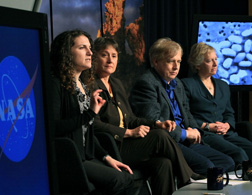Blogging the Periodic Table

There's a long, long history of biologists one-upping each other with bizarre new forms of life, but scientists have never discovered something quite like GFAJ-1, an arsenic-loving bacterium whose existence was announced on Thursday. The fact that GFAJ-1 can incorporate a toxic element is not what makes it remarkable. Some bacteria deep underground mine uranium to create energy. Sea squirts can substitute the obscure element vanadium for iron, which can turn their blood apple-green. Radiolarians (single-celled organisms) absorb silicon and use it like shiny glass armor. Many species make use of arsenic, too—certain ferns suck it out of the soil, for instance, and thrive while doing so. GFAJ-1 is different: It actually uses arsenic to grow.
Biologists often speak of CHONPS life—the concept that life as we know it cannot work without the elements carbon, hydrogen, oxygen, nitrogen, phosphorus, and sulfur. Arsenic sits below phosphorus on the periodic table, which means the two elements behave in similar ways in chemical reactions. In fact, that's largely why arsenic is toxic—among other nasty effects, it can wriggle into DNA, which uses phosphorus in the "backbone" of the double helix, and can interrupt the production of the energetic, phosphorus-based chemical that powers life, ATP. But because arsenic is bulkier and clumsier than phosphorus, it can't do the job as well, and cells start to die.
When scientists isolated GFAJ-1 in Mono Lake, Calif., they suspected it might interact with arsenic in an unusual fashion and perhaps even reveal something new about arsenic's role in biochemistry. Cut off from freshwater sources for the last 50 years, Mono Lake has accumulated high concentrations of salts and dissolved minerals, including some with arsenic. So any life there had to be pretty tolerant of the element already. When scientists returned to the lab with GFAJ-1 and slowly dialed down the amount of phosphorus in its environment, the microbes began to use arsenic to make DNA and other crucial cellular machinery. And they continued to thrive in frighteningly high concentrations of the stuff.
Far from being a mere curiosity, this new research has broad implications for biology. How, exactly, life pieced itself together from dead elements is the great outstanding mystery in biology, and some scientists now think that the oldest forms of proto-life—which might have sprung up in arsenic-rich hydrothermal vents—might have used this abundant element at first and only later switched over to phosphorus. The study also shows that even high levels of toxic (to us) elements on far-distant moons shouldn't necessarily rule out the chance that something could grow there.
Life based on exotic elements has long been a popular trope in science fiction. The most popular idea is that silicon could substitute for carbon (a possibility made all the more intriguing because silicon drives the modern computer industry). As I explain in my book, silicon-based life is a long shot—it just can't form the same versatile rings and complicated biochemicals that carbon can. Then again, until yesterday, arsenic seemed like a pretty poor bet, too.
Click here to launch slide show on what the elements look like.
Like Slate on Facebook. Follow us on Twitter.

